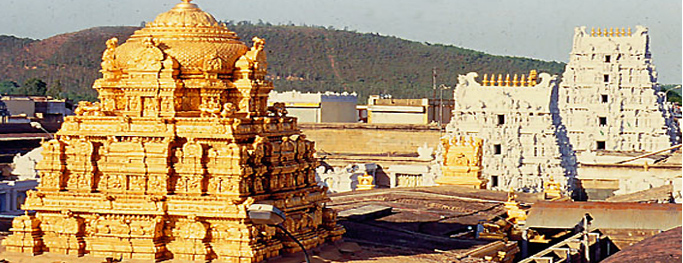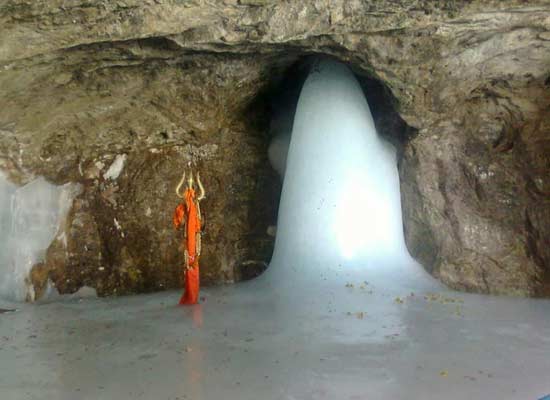Mathura
The city of Mathura, in Uttar Pradesh, the nucleus of Brajbhoomi, is located at a distance of 145 km south-east of Delhi and 58 km north-west of Agra. Covering an area of about 3,800 sq. km., today, Brajbhoomi can be divided into two distinct units - the eastern part in the trans-Yamuna tract with places like Gokul, Mahavan, Baldeo, Mat and Bajna and the western side of the Yamuna covering the Mathura region that encompasses Vrindavan, Govardhan, Kusum Sarovar, Barsana and Nandgaon.
The land of Braj starts from Kotban near Hodel about 95 km from Delhi and ends at Runakuta which is known specially for its association with the poet Surdas, an ardent Krishna devotee. A long line of picturesque ghats - with their steps leading to the water's edge, arched gateways and temple spires extending along the right bank of the River Yamuna, emphasise the sacred character of the town of Mathura. The birth place of Lord Krishna, "the best known, best loved and most complex of Lord Vishnu's manifestations" - Mathura is today an important place of pilgrimage.
Location
The city of Mathura is located in the western part of the state of Uttar Pradesh, in the northern region of India. It is a part of the great northern plains and is situated on the west bank of the river Yamuna. Mathura is 141 km south of Delhi and 47 km northwest of Agra. The climate of Mathura is extreme and tropical. Summers are extremely hot and winters are cold and foggy. It experiences southwestern monsoon rains from July to September.
History
An ancient city whose origins fade into the mists of history, Mathura's strategic location at the cross roads of various trade routes - that went westwards to West Asia and the Roman Empire; northwards, via Taxila, Pushkalavati and Purushapur to Central Asia and the Silk Route and eastwards to China - ensured its position as a centre of trade and a meeting point for varied cultures.
By the fifth century BC, during the time of Buddha, it was a major metropolis and the capital of the Surasena Kingdom - one of the 16 Mahajanapadas of the period. Mathura saw its `golden age' during the rule of the Kushanas and the able governance of rulers like Kanishka, Huvishka, and Vasishka, when the arts flourished and economic wealth grew. It remained a centre of power during the Mauryan period, through the enlightened rule of Emperor Ashoka (3rd century BC) to the Gupta era (4th century AD).
Brij Culture in Mathura
According to the Bhagwat Purana, Shri Krishna along with the gopis had danced the Raas on the banks of the Yamuna at Vrindavan. When the gopis felt conceited about Lord Krishna dancing with them, he disappeared from their midst. In the agony of separation from their beloved Krishna, the gopis recalled and enacted his lilas (divine episodes of his life) which in course of time came to be known as the Raaslilas. The Raaslila in its present form is ascribed to Swami Haridas and Shri Narayan Bhatt. Only young Brahmin boys of 13 to 14 years of age can perform the Raaslila. The charming childhood pranks of Shri Krishna constitute the main them of these dramas.
Popular Pilgrimage Attractions
Radharamana Temple
This is the famous temple of Gopala Bhatta Gosvami. Radharamana means "one who gives pleasure to Radha", and is one of the many names of Lord Krishna. The seva puja of Radharamana was established in 1542, after the Deity self-manifested from a saligram-sila. Also kept iin this temple is the wooden sitting place (hoki) and shawl (chaddar) or Lord Chaitanya, that He gave as a gift to Gopala Bhatta Gosvami. There is no deity of Radharani in this temple, but a crown is kept next to Krishna signifying Her presence.
Jugal Kisore Temple
This is one of the oldest temple of Vrindavana and was completed in 1627. After Emperor Akbar's visit to Vridavana in the year 1570, he gave permission for four temples to be built by the Gaudya Vaisnavas, which were Madana-mohana, Govindaji, Gopinatha and Jugal Kisore. It is sometimes called the Kesi ghata temple, as it is located next to this ghata.
Kesi Ghata
This is the place where Lord Krishna killed the Kesi demon who appeared in the form of a gigantic horse and then took His bath in this very same ghata. This is also very famous bathing place in Vrindavana. An arati to Yamuna Devi is held here every evening.
Rangji Temple
This South Indian style temple was built by the wealthy Seth family of Mathura in the year 1851, and is dedicated to Lord Sri Ranganatha or Rangaji - a form of Lord Vishnu lying down on the Sesa Naga (celestial serpent). This temple has a traditional South Indian gopuram (gateway) and is surrounded by high walls. It is one of Vrindavana's largest temples. Once a year a grand car festival (Ratha Yatra) is held known as Brahmotsava, during the month of Chait (March - April), this festival lasts for 10 days.
Dwarkadish Temple
The Dwarkadish Temple, built in 1814, is a popular temple in the center of town. This is the most visited temple in the center of town. This is the most visited temple in Mathura. This temple is managed by followers of Vallabhacarya. Once you enter this temple from the street, it is fairly interesting architechually and there is a lot of activity inside. It is located in the eastern part of Mathura, not far from the Yamuna River.
Recommended Religious India Tours

Duration:10 Nights / 11 Days
Destinations: Haridwar - Jhanki Chatti - Yamunotri - Syana Chatti - Gangotri

Duration: 5 Nights / 6 Days
Destinations: Delhi - Jammu - Katra - Darshini Darwaja - Banganga Temple

Duration:8 Nights / 9 Days
Destinations: Srinagar - Pahalgam - Chandanwari - Sheshnag - Panchtarni - Amarnath

